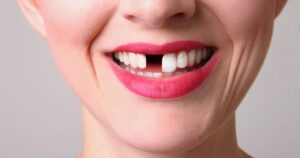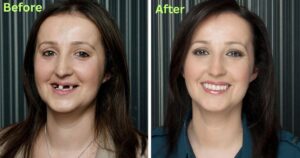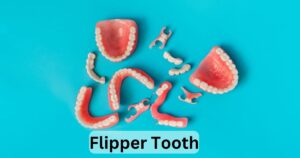Dentures are artificial teeth. They replace missing natural teeth. People wear them to eat and smile better. Dentures can be full or partial, and they’re usually made by a dentist.
What Do Bottom Dentures Look Like? Well, imagine a sturdy row of lifelike teeth, neatly crafted to fit snugly on your lower gums. Bottom dentures resemble a natural smile’s foundation, custom-made for each individual. They mimic the appearance of real teeth, ensuring you can eat, speak, and grin with confidence.
Now that you have a glimpse of what bottom dentures look like, if you’re considering them as a solution, consult a dentist for personalized advice. They can help you achieve a smile that suits you best. Don’t hesitate to take that step towards a confident, natural-looking smile today.
Why Won’t My Bottom Dentures Stay in Place?
Bottom dentures may not stay in place for a few reasons. One common cause is changes in your jawbone over time, making the fit less secure. Sometimes, the dentures themselves may not be properly fitted.
Lifestyle factors like diet and speaking patterns can affect denture stability. Eating hard or sticky foods can dislodge them, and speaking too quickly may cause slippage. Learning to adapt your habits and ensuring proper maintenance can help improve the stability of your bottom dentures for a more comfortable experience.
| Method | Description |
| Denture Adhesives | Use denture adhesives in the form of creams or powders to enhance grip and prevent slippage. |
| Regular Dental Check-ups | Visit your dentist regularly for adjustments to improve the fit of your lower dentures. |
| Dental Implants | Consider dental implants for a long-term, stable solution to keep lower dentures in place. |
| Practice, Practice, Practice | Continuously practice wearing dentures to become more confident and skilled in using them. |
| Denture Cushions or Pads | Use soft materials under dentures to improve their grip and reduce irritation. |
A Flat or Negative Ridge
A flat or negative ridge is a dental term. It means the gum ridge is not curved like normal. Instead, it appears flat or slopes inward. This condition can make it challenging for dentures to stay in place. Dentists may use special techniques or materials to improve the fit of dentures on a flat or negative ridge.
The Denture Teeth are Not Properly Aligned
When denture teeth aren’t aligned right, it can cause discomfort. Eating and speaking might be challenging. A dentist can adjust them to fit better. Proper alignment ensures a more comfortable experience with dentures.
Impatience
Impatience can be a common reason why bottom dentures won’t stay put. People often expect instant results. However achieving a secure fit takes time and adjustments. Impatience can lead to improper use, making it harder for dentures to stay in place.
The Best Ways to Get Lower Dentures to Stay in Place
When it comes to keeping lower dentures in place and making dentures fit better at home, there are some simple but effective methods to ensure a secure fit. One key approach is using denture adhesives. These products, available in various forms like creams or powders, can enhance the grip of your lower dentures, preventing them from slipping during daily activities.
Another helpful strategy is to visit your dentist regularly. Dentists can make necessary adjustments to the dentures to improve their fit. Dental implants can be a long-term solution for a more stable lower denture.
Practice, Practice, Practice
Practice, practice, practice is the key to improvement. Whether it’s playing an instrument, a sport, or a new skill, repetition helps you get better. The more you practice, the more confident and skilled you become. So, keep at it and watch your progress soar.
Denture Adhesives Have Their Place
Denture adhesives serve a purpose. They help dentures stay in place. Some people use them for added confidence. But not everyone needs them. It’s important to use adhesives as directed for best results.
Extra Security
For extra security, consider denture adhesives. These products can enhance the grip of your lower dentures. Apply a small amount to your clean dentures and place them in your mouth. This can help keep them stable throughout the day.
Another option is dental implants. These are like artificial tooth roots that support your dentures. They offer a secure foundation, preventing slippage and enhancing comfort. Talk to your dentist about these solutions for added confidence in your lower dentures staying in place.
Best Dentures for Lower Teeth

When it comes to finding the best dentures for lower teeth, there are several factors to consider. These dentures are designed to replace missing lower teeth, and the right choice depends on your unique needs and preferences.
One option is removable partial dentures, which can replace a few missing lower teeth. They’re easy to clean and maintain. Another choice is implant-supported dentures, which are more stable and secure, anchored by dental implants in the jawbone.
Common problems with bottom dentures
Common problems with bottom dentures can include discomfort when eating or speaking. They might sometimes move around or slip, causing irritation. Sore spots and gum pain can also be issues. Regular check-ups with your dentist can help address these problems for a more comfortable and confident experience.
Implant retained dentures
Implant-retained dentures are a modern dental solution. They use dental implants as anchors. These implants provide a secure hold for dentures. This means no slipping or discomfort. It’s a popular choice for those seeking stable and natural-looking dentures.
What is the difference between upper and lower dentures?
Upper and lower dentures differ in their placement. Upper dentures replace missing teeth on the top jaw, while lower dentures replace those on the bottom. The upper ones cover the palate, while lower dentures are U-shaped to accommodate the tongue.
Upper dentures tend to be more stable since they have the palate for support. Lower dentures can be less stable due to the tongue’s movements and the narrower lower jaw ridge.
How To Secure Lower Dentures?
Securing lower dentures is essential for comfort and confidence. Here’s how you can do it. First, consider using denture adhesive. It’s a glue-like substance that helps hold the dentures in place. Apply a small amount to the lower denture, then press it onto your gums for a secure fit.
Another option is using denture cushions or pads. These soft materials can be placed under the dentures to improve their grip and reduce irritation. Regular dental check-ups are crucial too, as your dentist can adjust your dentures if they become loose over time.
How Do I Keep My Bottom Dentures From Falling Out?
Worried about your bottom dentures staying in place? Here’s what you can do to keep them from falling out. First, make sure they fit properly. Your dentist can adjust them if needed. Second, use denture adhesive. It helps create a secure hold.
Try to avoid biting into very hard or sticky foods. When you’re not wearing your dentures, keep them clean and moist to maintain their shape. If you follow these simple steps, you’ll enjoy a more comfortable and worry-free experience with your bottom dentures.
FAQ’s
Can they match my original teeth?
Yes, bottom dentures are crafted to blend seamlessly with your unique smile, making them almost indistinguishable from your natural teeth.
Do they feel comfortable to wear?
When properly fitted, bottom dentures are comfortable and allow you to eat, speak, and smile with confidence.
How do I care for them?
Maintain your bottom dentures by cleaning them regularly and keeping them moist when not in use. Consult your dentist for specific care instructions.
Conclusion
What bottom dentures look like is key to gaining confidence and comfort. These dentures are crafted to resemble a natural set of teeth, fitting snugly on your lower gums. With proper care and adjustments from your dentist, they become almost indistinguishable from your original teeth.
So, if you’re considering bottom dentures, consult your dentist. They can ensure a perfect fit and guide you on care and usage. With time and practice, you’ll adjust to speaking and eating comfortably, allowing you to embrace your beautiful, natural-looking smile with ease.











